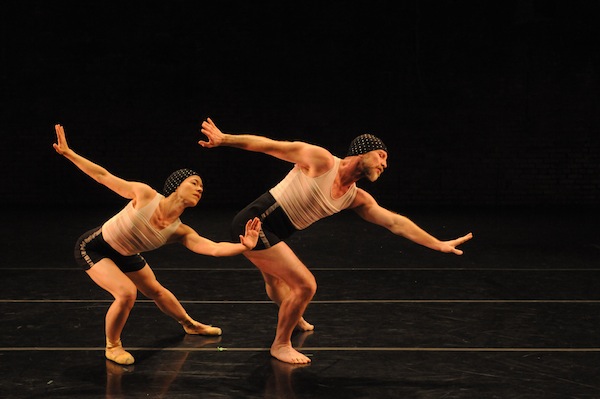
Ruminations from inside and outside a dance
By Penelope Freeh, American Composers Forum
In March I re-set Slippery Fish, my work in collaboration with composer Jocelyn Hagen, on two new dancers. We are touring the piece to the new Links Hall at Constellation in Chicago June 7-9. A magical week opened up so I grabbed it, to re-work as needed and really pass the steps on (and the intentions behind them) with the integrity that comes with having time.
With the help of an American Composers Forum Live Music for Dance Minnesota Grant, Slippery Fish began as two simultaneous duets: two dancers and two musicians (soprano and viola). What ended up occurring is a quartet, all bodies ever-present onstage, interacting, affecting and framing. The work creates its own ecosystem of sound, gesture and collective history. Seeing it take shape through the lens of two new bodies was satisfying in the extreme. I am still in the piece but cannot perform for one out of the three Chicago performances, so I hired Eve Schulte to learn my part. A colleague from James Sewell Ballet, she is at the top of her game. Stephen Schroeder is the other dancer, whip-smart and sensuous. They make a great pair.
Rebuilding the timings and rhythms, initially without the musicians, made me crave their sound even more, knowing as I do so intimately how profoundly they contribute to the work. Soprano Carrie Henneman Shaw is mighty, a petite powerhouse of a singer who, in the middle of the piece, actually floats the male dancer on her hip. It is an ethereal moment, defying gravity and preconceived notions. We call it the spiral section and the image is that of moving under water. “Turtle” is next as Carrie steps upon my back; for a brief moment her chin is above the waterline.
Slippery Fish opens in darkness as the violist (the wonderful and game Sam Bergman) strikes the strings with his bow, a tenuous sound and unnerving. Across the space Stephen wavers, slowly executing arm gestures. With eyes closed, he is the visual manifestation of the music. Carrie enters, a spoke behind the dancer on the diagonal. They do the arm gestures in unison as the tempo increases and stability occurs. The second dancer enters. Repeat with eyes open.
This slow-burn episode takes about 4 minutes, a build and then a bursting as the dancers double over and the singer retreats, beginning her virtuosic dum dum das. She sings wordlessly throughout, co-creating a foreign environment of furious and gentle sound.
From underwater the piece lands in a fiery world. There is a duet for the female dancer and the violist. The other two walk, tracing specific patterns, now intersecting, now framing. A percussive section ensues, a memory from Jocelyn’s childhood that we all infiltrate and amplify. Tumbling toward the end there is a final dancing burst in what is perhaps my favorite section. The dancers dance a yummy and weird movement phrase, first a solo, then a duet and finally a fractured structure that pauses in spots, relishing synching up.
Stylized poses become gestures become degradations. The end is a miracle of duration and light, retreating sound and minimalism.
Re-setting this work brings it even closer to my heart. I think about working with live musicians and in general about how it is to collaborate with a composer. It makes so much sense to me that this is now my interest and intention. Tracing my steps back, all along I’ve been a musical dancer, deeply hooked in to rhythms and the negative spaces of sound. As a choreographer I’ve often strung together pieces of music, working with an editor to create a soundscape that follows the arc of a dance. I’ve inserted silence and sound effects, juxtaposed arias with Marlene Dietrich.
Working directly with a composer is, well, more direct. The trajectory of the work can be discovered together, responded to in the moment, amplified to something greater than the sum of the parts.
Jocelyn and I work well together. We share a sense of pacing and duration but also aren’t afraid to question one another, opening cans of worms and creating wrinkles. Ironing them out pushes us to go deeper.
Next we are taking on a gargantuan task: something we are calling a dance opera. With a string quartet, six singers and four dancers, this new work will be an oblique narrative about the birth of flight. Tracing the timeline of the Wright Brothers and the experiments that led to the “first flight” in 1903, the story will be told through a single voice, a soprano portraying Katherine Wright, the sister who shared the dream and facilitated their success. Two male dancers will portray the brothers and two female dancers will portray the airplane. Five male singers will serve as the witnesses who were present for that historic moment. All the players will be used in additional imagistic and impressionistic passages, breaking from the story to look at aviation through other lenses, personal and historic. It’s called Test Pilot and while we haven’t formally started working yet, our thoughts are constantly ruminating on it. We are thrilled to have secured a producer, The O’Shaughnessy Women of Substance series. It will premiere in September 2014.
But first we heed the call back to Slippery Fish. The spark is lit.
Recent Content
-
Artsarticle ·
-
Artsarticle ·
-
Artsarticle ·
